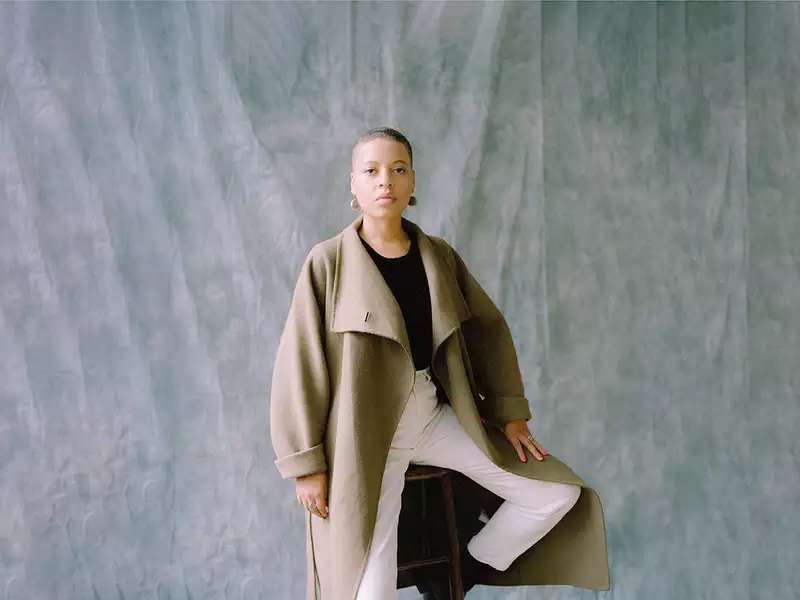The art history program, and Barnard itself — the environment, the rigor, the community — gave me that strength and was so fundamentally important in how I negotiated the world and took risks.
[Photo: A site-specific installation for the exhibition “Ballast & Barricades," at the Institute for Contemporary Art (ICA) Philadelphia through May 10, 2020.]
Artist Michelle Lopez ’92 wants to challenge her viewers’ perceptions with metals that bend and fold and large scaffolding that hovers precariously on diminutive stands. She makes seemingly substantial forms appear to dissolve or disappear completely. By using techniques for large-scale installations and sculptures that apparently defy the properties of the materials she uses, Lopez says she seeks to represent and respond to the challenges and political struggles of the world.
It’s this kind of boundary-pushing that earned Lopez a Guggenheim Fellowship last year for her new work The Joplin Project, which is slated for a fall 2020 display at the Franklin Institute in Philadelphia. The Joplin Project is an immersive experience of tornadoes that draws upon engineering and music.
Lopez is persistent when pursuing her goals; she applied for the fellowship six times before she was successful. “[The last] time around, I didn’t expect it,” said Lopez, an assistant professor in the University of Pennsylvania’s Stuart Weitzman School of Design. “You develop this hard skin when you have to keep going.”
Raised in Alexandria, Virginia, by parents who emigrated from the Philippines, Lopez went to an all-girls’ Episcopal private school through high school and took art classes at the local art league, the Torpedo Factory, as well as at Washington, D.C.’s Corcoran Gallery School of Art.
At Barnard, she double-majored in art history and English while also taking many studio art classes. Lopez credits Joan Snitzer, senior lecturer in art history and co-chair and director of visual arts, for significant encouragement and guidance. “Her teaching in post-modern theory was highly influential,” said Lopez, who also went on Snitzer’s trips to Soho galleries and artist studios as a student.
By her senior year, Lopez had moved downtown to be more fully engaged with the art scene. She waited tables at the Odeon restaurant, one of the gathering spots for contemporary artists. Still, Lopez didn’t hone in on sculpture as her medium until she attended graduate school at the School of Visual Arts and attempted large-scale pieces to “get beyond [herself].” The themes that Lopez has become increasingly known for — brokenness, debris, collapse, ruins — came into sharper focus after the events of 9/11.
“I had been making art for a while and was scheduled to be in Soho [on] September 13, 2001,” she remembered. “We were installing [a]show when everything changed. I didn’t want to do the show. It was a very intense moment. The show was a non-show. I looked at the time before 9/11 and the time after, and I didn’t want to make the same work anymore.”
She added, “After 9/11, I became interested in sculpture as debris, rather than the finish-fetish work I had been making.” She became focused on exploring the tension between being “broken and imperfect within the figure or object at hand with its former perfect, or seemingly perfect, self.”The 2016 election tightened Lopez’s focus. “It was about the tension of being on the verge of collapse,” she said of her most recent show. “I wanted sculpture to have its own agency in the most delicate, minimal way possible.”
Up next, besides The Joplin Project, is a public commission of a chandelier in Manila. And of course, there are other things to juggle, such as being the single mother of a teenage son and leading the sculpture division in the Fine Arts program at the University of Pennsylvania.
“I try to be as holistic as possible, to have the teaching support the art and the art support the teaching,” Lopez said. “Penn is most supportive of my work. I have to protect the time in the studio. It’s hard.”
But it gets easier with Barnard as a foundation that Lopez continues to draw upon. “Joan [Snitzer] has consistently come to all my shows, and is so supportive of me — she’s my art mom,” said Lopez. “Barnard women are really special. There’s a certain kind of intellect and confidence that I took with me. It’s a certain kind of humor, sass, a certain kind of edge and pushing the boundaries. The art history program, and Barnard itself — the environment, the rigor, the community — that gave me that strength and was so fundamentally important in how I negotiated the world and took risks.”
—MERRI ROSENBERG ’78



